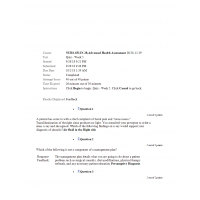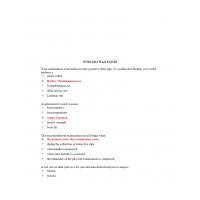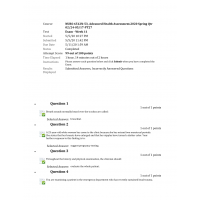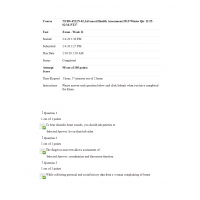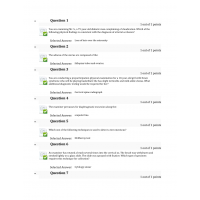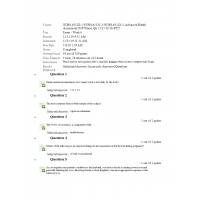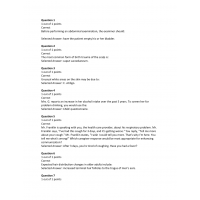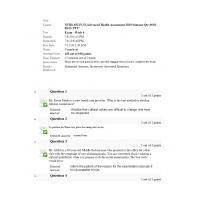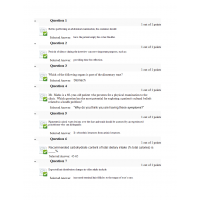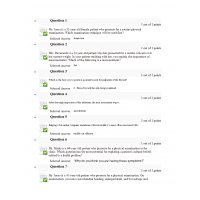NURS 6512N Week 2 QUIZ
1. When percussing, a dull tone is expected to be heard over:
2. The dorsal surface of the hand is most often used for the assessment of:
3. A patient in the emergency department has a concussion to the head. You suspect the patient may also have a retinal hemorrhage. You are using the ophthalmoscope to examine the retina of this patient. Which aperture of the ophthalmoscope is most appropriate for this patient?
4. The use of secondary, tangential lighting is most helpful in the detection of:
5. Tuning forks with a frequency of 500 to 1000 Hz are most commonly used to measure:
6. Which patient is at the highest risk for the development of latex allergy?
7. A variant of the percussion hammer is the neurologic hammer, which is equipped with which of the following?
8. Transillumination functions on the principle that:
9. Which statement is true regarding the relationship of physical characteristics and culture?
10. All cultural traits can be viewed as static whereas physical traits are dynamic.
11. Which technique is commonly used to elicit tenderness arising from the liver, gallbladder, or kidneys?
12. A rubber or plastic ring should be around the bell end-piece of a stethoscope to:
13. In terms of cultural communication differences, Americans are more likely to _____ than are other groups of patients.
14. For a woman with a small vaginal opening, the examiner should use a _____ speculum.
15. During percussion, the downward snap of the striking fingers should originate from the:
16. You are auscultating a patient s chest. The sounds are not clear, and you are having difficulty distinguishing between respirations and heartbeats. What technique can you use to facilitate your assessment?
17. Expected normal percussion tones include:
18. During auscultation, you can limit your perceptual field best by:
19. Standard Precautions apply to all patients:
20. Which of the following describes a physical, not a cultural, differentiator?
NURS-6512N-28,Advanced Health Assessment
1. When percussing, a dull tone is expected to be heard over:
2. The dorsal surface of the hand is most often used for the assessment of:
3. A patient in the emergency department has a concussion to the head. You suspect the patient may also have a retinal hemorrhage. You are using the ophthalmoscope to examine the retina of this patient. Which aperture of the ophthalmoscope is most appropriate for this patient?
4. The use of secondary, tangential lighting is most helpful in the detection of:
5. Tuning forks with a frequency of 500 to 1000 Hz are most commonly used to measure:
6. Which patient is at the highest risk for the development of latex allergy?
7. A variant of the percussion hammer is the neurologic hammer, which is equipped with which of the following?
8. Transillumination functions on the principle that:
9. Which statement is true regarding the relationship of physical characteristics and culture?
10. A scale used to assess patients weight should be calibrated:
11. Which technique is commonly used to elicit tenderness arising from the liver, gallbladder, or kidneys?
12. A rubber or plastic ring should be around the bell end-piece of a stethoscope to:
13. In terms of cultural communication differences, Americans are more likely to _____ than are other groups of patients.
14. For a woman with a small vaginal opening, the examiner should use a _____ speculum.
15. During percussion, the downward snap of the striking fingers should originate from the:
16. You are auscultating a patient s chest. The sounds are not clear, and you are having difficulty distinguishing between respirations and heartbeats. What technique can you use to facilitate your assessment?
17. A normal lung produces resonance percussion tones while an empty stomach is expected to produce tympany. Dull percussion tones are heard over the liver.
18. During auscultation, you can limit your perceptual field best by:
19. Standard Precautions apply to all patients:
20. Which of the following describes a physical, not a cultural, differentiator?
NURS 6512N Week 2 Quiz 3
1. Guidelines for Standard Precautions indicate that mask and eye protection or a face mask should be worn while performing
2. Standard Precautions apply to all patients
3. According to the guidelines for Standard Precautions
4. One recommendation to prevent latex allergy is to
5. Which patient position is useful for auscultating heart tones?
6. Which technique is used during the history taking and the physical examination process?
7. Which examination technique should be used first?
8. The use of secondary, tangential lighting is most helpful in the detection of
9. A nonambulatory 80-year-old male patient tells the female nurse that he feels like he is having drainage from his rectum. Which initial nursing action is appropriate?
10. You are conducting a head to toe examination as part of a patient's preventive health assessment. The room has adequate lighting, and you have access to both sides of the examining table. What position should you assume while conducting this examination?
11. Which part of the examiner's hand is best for palpating vibration?
12. The dorsal surface of the hand is most often used for the assessment of
13. When conducting the abdominal examination, after you inspect, you proceed next to
14. Expected normal percussion tones include
15. When percussing, a dull tone is expected to be heard over
16. During percussion, the downward snap of the striking fingers should originate from the
17. Which technique is commonly used to elicit tenderness arising from the liver, gallbladder, or kidneys?
18. During auscultation, you can limit your perceptual field best by
19. You are auscultating a patient's chest. The sounds are not clear, and you are having difficulty distinguishing between respirations and heartbeats. What technique can you use to facilitate your assessment?
20. When examining the abdomen, which technique should be used first?
21. Auscultation should be carried out last except when examining
22. Which of the following statements is true regarding tympanic membrane temperature?
23. It is an accurate measurement of body temperature because the tympanic membrane shares its blood supply with the hypothalamus.
24. A scale used to assess a patient's weight should be calibrated
25. The height-measuring attachment of the standing platform scale should be pulled out
26. An infant should be placed in which position to have his or her height or length measured?
27. The stethoscope's diaphragm is most useful in the assessment of _____ sounds.
28. A rubber or plastic ring should be around the bell endpiece of a stethoscope to
29. Which technique should be used to stabilize the stethoscope during auscultation?
30. A patient in the emergency department has a concussion to the head. You suspect that the patient may also have a retinal hemorrhage. You are using the ophthalmoscope to examine the retina of this patient. Which aperture of the ophthalmoscope is most appropriate for this patient?
31. The Tumbling "E" vision acuity chart would most likely be used for _____ patients.
32. The pneumatic attachment for the otoscope is used to evaluate
33. The patient tells you that his ears are "stopped up." An objective assessment of this complaint is achieved by using a(n)
34. Tuning forks with a frequency of 500 to 1000 Hz are most commonly used to measure
35. To perform a deep tendon reflex measurement, you should
36. A variant of the percussion hammer is a neurologic hammer, which is equipped with which of the following?
37. When monitoring serial measurements, such as head circumference or abdominal girth, which procedure is best to ensure that the tape measure is placed in the same position each time?
38. Transillumination functions on the principle that
39. When performing transillumination of a body cavity, the use of which of the following could be harmful to the patient?
40. For a woman with a small vaginal opening, the examiner should use a _____ speculum.
NURS 6521N Week 2 Quiz 4
1. You are performing a vaginal examination on a patient with a history of spina bifida. As you insert the metal speculum, the patient suddenly feels nauseated and is sweating, and her skin turns blotchy. What is your most immediate reaction to this situation?
2. Mr. Walder is a 56-year-old man who has been complaining of chest palpitations. Which position is useful for auscultating heart sounds?
3. Which technique is used during both the history taking and the physical examination process?
4. Ms. Jones is a 31-year-old female patient who presents for a routine physical examination. Which examination technique will be used first?
5. The use of secondary, tangential lighting is most helpful in the detection
6. You are caring for a nonambulatory 80-year-old male patient and he tells you, a female nurse, that he feels like he is having drainage from his rectum. Which initial nursing action is appropriate?
7. Mrs. Smalls is a 42-year-old woman who has presented to the office for a head to toe examination as part of her preventive health care assessment. The room has adequate lighting, and you have access to both sides of the examining table. What position should you assume while conducting this examination?
8. You are planning to palpate the abdomen of your patient. Which part of the examiner's hand is best for palpating vibration?
9. Mrs. Berger is a 39-year-old woman who presents with a complaint of epigastric abdominal pain. You have completed the inspection of the abdomen. What is your next step in the assessment process?
10. The degree of percussion tone is determined by the density of the medium through which the sound waves travel. Which statement is true regarding the relationship between density of the medium and percussion tone?
11. Expected normal percussion tones include:
12. During percussion, a dull tone is expected to be heard over:
13. When using mediate or indirect percussion, which technique is appropriate?
14. During percussion, the downward snap of the striking fingers should originate from the:
15. During auscultation, you can limit your perceptual field best by:
16. You are auscultating a patient's chest. The sounds are not clear, and you are having difficulty distinguishing between respirations and heartbeats. Which technique can you use to facilitate your assessment?
17. Auscultation should be carried out last, except when examining the:
18. Tympanic thermometers measure body temperature when a probe is placed:
19. The height-measuring attachment of the standing platform scale should be pulled up:
20. Which of the following occurs when firm pressure is used to apply the stethoscope's bell endpiece to the skin?
21. Weak pulses, fetal heart activity, and vessel patency are all best assessed with which type of stethoscope?
22. You are using an ophthalmoscope to examine a patient's inner eye. You rotate the lens selector clockwise and then counterclockwise to compensate for:
23. A patient in the emergency department has a concussion. You suspect the patient may also have a retinal hemorrhage. You are using the ophthalmoscope to examine the retina of this patient. Which aperture of the ophthalmoscope is most appropriate for this patient?
24. Which type of speculum should be used to examine a patient's tympanic membrane?
25. The pneumatic attachment for the otoscope is used to evaluate:
26. Mr. Walters, a 32-year-old patient, tells you that his ears are "stopped up." An objective assessment of this complaint is achieved by using the:
27. To perform a deep tendon reflex measurement, you should:
28. Then monitoring serial measures, such as head circumference or abdominal girth, which procedure is best to ensure that the tape measure is placed in the same position each time?
29. The Pederson speculum has blades that:
30. Which of the following are causes of hyperreflexia? (Select all that apply.)
31. Insertion of a speculum
32. The Snellen E vision acuity chart would most likely be used for __________.
33. The stethoscope's diaphragm is most useful for the assessment of __________ sounds.
34. For a woman with a small vaginal opening, the examiner should use a __________ speculum.
| Institution & Term/Date | |
| Term/Date | Walden University |
NURS 6512N Week 2 Quiz with Answers (04 Sets)
- Product Code: 2019
- Availability: In Stock
-
$14.99
Related Products
Tags: nurs 6512n





